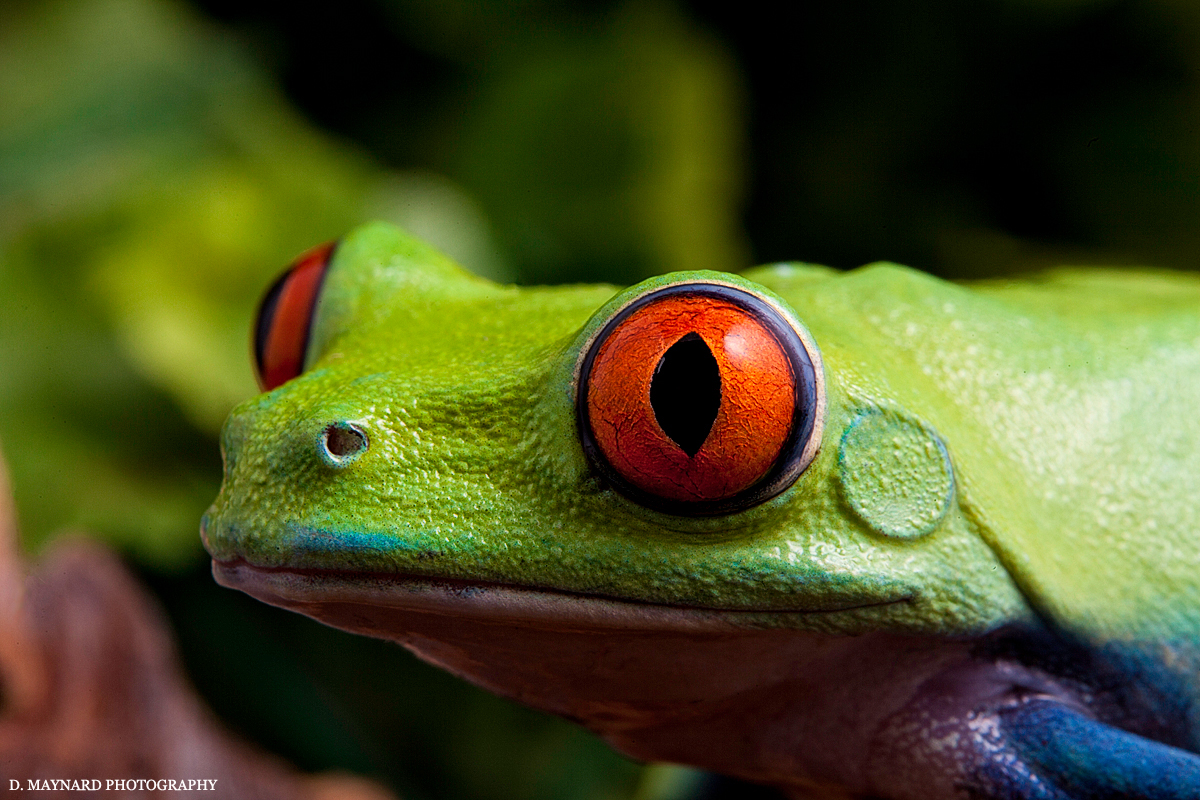How To: Take Macro Photos, No Matter Where You Are
David Guy Maynard uses the Tamron SP 90mm F/2.8 VC lens to zoom in on the most intricate details of the tiniest subjects.
By Jenn Gidman
Images by David Guy Maynard
David Guy Maynard doesn't mind traveling—in fact, he often appreciates the change of scenery, whether he's working for a few weeks in Germany or leading a workshop somewhere closer to home in the States. But while his travel, nature, and street photography gets an ample workout via these far-flung locales, there's one type of photography he especially enjoys, and he doesn't even have to leave his backyard.
"Macro photography is the only genre where you can always find something in the tiniest of spaces," David explains. "I happen to be lucky in that I live in Florida, so there's always something for me to take pictures of, whether it's an exotic cactus, bug, bird, or lizard. Plus, unlike most other genres, I can sometimes photograph a dozen different subjects, all with their own unique look and feel, by moving just 4 feet."
Even people in colder climates can find something to put in front of their lens. "Maybe there's too much snow on the ground to document any type of wildlife or plant life, but you can capture the details in a patch of ice," David says. "Or you can find stuff inside your home to shoot if the weather is really inclement: One rainy day I took the back off of a watch and spent an hour photographing the minuscule gears inside. It was a fascinating world I never really paid attention to."
Here, with accompanying photos, are some of David's tips for plumbing the macro depths in your own domain.
Use a light tent.
When I find a frog in the wild, I'll often move it to a different location—you just have to be gentle and respectful so it doesn't get hurt. There are times when I'll find a nocturnal tree frog here in Florida, but maybe it's sitting on an ugly stone walkway or a beat-up fence and I don't like the background. I'll take it and move it a few feet to where there's some greenery, gently set it down, then let it get settled in against that better background before I take a photo.
This red-eyed tree frog you see here is an exotic, but I happened to photograph it in front of a live audience at a macro workshop while I was demonstrating how to set a scene up. He was perched on a little piece of driftwood made for a fish tank. The greenery you see in the background is also an aquarium accessory, not a real plant.
When I'm not out in the wild, I really like using tiny light tents for my macro work. They're very handy and distribute the light nicely. With that pinpointed light coming in from two or three sides, it literally broadcasts the light everywhere and still allows you to capture that deep depth-of-field at a higher aperture. This frog was in one of those light tents with an inserted background inside, and with two lights (one from each side) illuminating the tank.
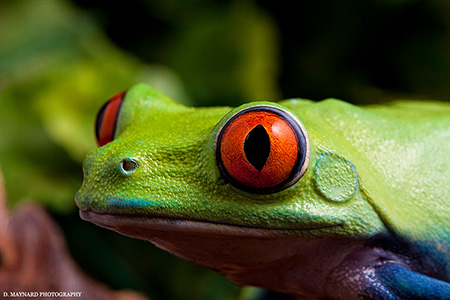
90mm, F/16, 1/60th sec.
The peacock tree frog you see in the second image belongs to my assistant, Sammi, and he's a real loudmouth: He actually meows like a cat. When it expands, the pouch you see under his chin is almost as big as his entire body. You'll notice there are two catchlights visible in each eye. Normally I don't like having two catchlights like this, but in this case I didn't mind it—it gives a great gleam. I had him inside the same light tent, and I was hitting him from both sides with the light.
It's worth noting his texture as well. If you look at his face, you can see how wet and reflective it is, which can be a challenge for picture-taking. That's another reason I love the light tents. Putting the frog inside one deadens a lot of that glare because your lights are off to the sides—you're not getting a direct reflection like you would if your light were on-camera, which would cause glare and make you lose much of the detail in its body.
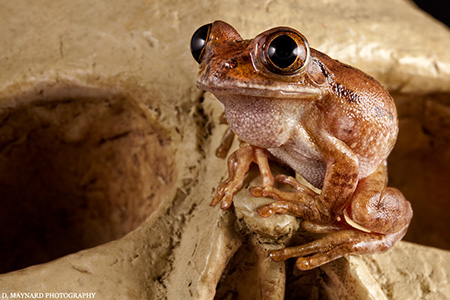
90mm, F/22, 1/80th sec.
Control your backgrounds.
Here in Florida we have lizards all over the place known as anoles. We have green southern anoles, which you won't see as frequently, and brown Cuban knight anoles, which tend to eat the green ones. They're voracious and vicious, whether they're fighting or mating.
This anole I photographed was in a cactus patch, so I had to shimmy in very carefully, because it's very painful if you get pricked by a cactus, and I was wearing a T-shirt and flip-flops. The cactuses are gorgeous, but the gravel underneath this one was made up of dull, gray pebbles, and I didn't like the looks of it.
The beauty of shooting the way that I do is that I don't have to follow the rules we used to have to follow. In other words, if I have a subject that's composed nicely and on a branch or a leaf where the background doesn't suit me, I can just use high-speed sync with my flash, which lets me use the flash at higher shutter speeds than my camera's maximum. By jamming it up to, say, 1/2000th of a second and filling in with the flash in high-speed sync, I can knock out any distracting background that's 2 or 3 inches behind my subject and turn it into complete darkness.
Sometimes that technique doesn't work, however, like when the background is very close. One other trick I use is to carry around a little pop-out reflector kit. I have ones with sleeves, in black, white, gold, and silver versions, as well as a diffusing panel. If you use the black side, a lot of times you can tuck it behind your subject and create a black backdrop right in the wild. It's an invaluable tool out in the field. As for the diffuser panel, if you have really intense sunlight hitting your subject from above, that diffusion panel held over your subject cuts the sunlight enough that it mellows everything out and gives you an even exposure.
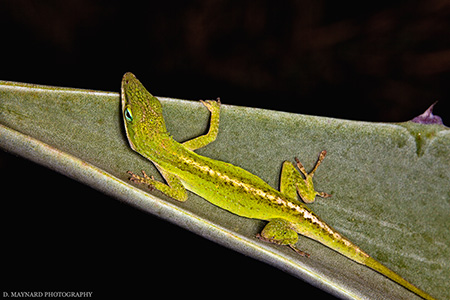
90mm, F/32, 1/250th sec.
Seek out eye-catching lines and patterns.
I'm a huge fan of architecture. I love the lines and angles you can find when photographing unique buildings. I find similar geometry in nature. With this cactus plant, it looks so organic, with the rounded edges of the green and flowing lines leading right into the soft middle. You can see a shimmer where the ringlight is hitting. And at the upper edges you get a sheen, because of the plant's moisture. Finally, you have these spires poking out, almost like antenna towers. I find it fascinating to think about how organic and yet how stringent nature can be all on its own—it's sacred math at work.
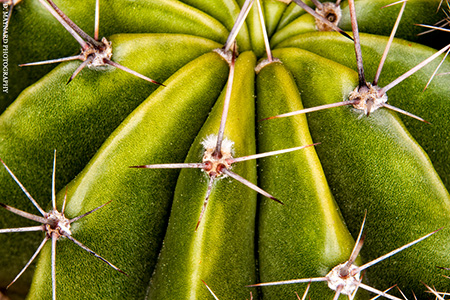
90mm, F/32, 1/200th sec.
The same applied for the flowers on this native Southern plant. The image is actually inverted: The flowers were hanging downward, then I flipped it when I brought it into Photoshop. It's an absolutely beautiful plant, with long, thick green leaves. Photographing plants like this, where you're really taking a closer look at it, gives you a deeper appreciation for every tiny cell you look at, every organism, every creature.
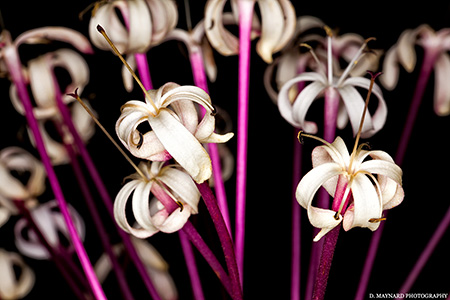
90mm, F/16, 1/250th sec.
Light foliage from behind.
When I shoot leaves, I love to backlight them, either with an off-camera flash that I can trigger from my camera or with a ringlight. I do this because while leaves are pretty, they're not exactly that captivating—until you get up really close and see their organic architecture and what that leaf is really about: all of its veins, its arteries, how it works. It's the true story of that living object. It's discovery. I imagine it's largely how Charles Darwin felt when he spent all those months in the Galapagos Islands—that wonder, that sense of being a child in the world, marking every detail.
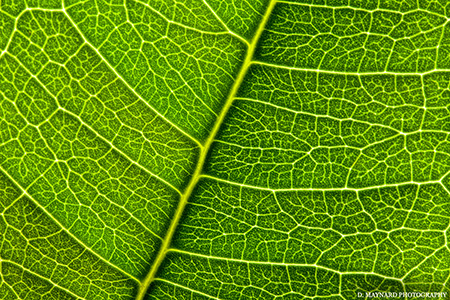
We live our lives every single day with what we've been trained to see, whether it's visually or politically or esoterically. We learn not to notice new things. Photography helps us look all around us and notice, whether you're gazing up into deep space or examining the details of the tiniest things on this planet. Knowing I've been in my own bubble and never noticed something before allows me to understand my place in this place—at least a little better than I did before."
To see more of David Guy Maynard's work, go to Instagram.
